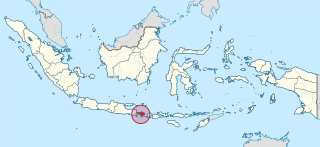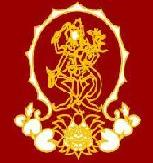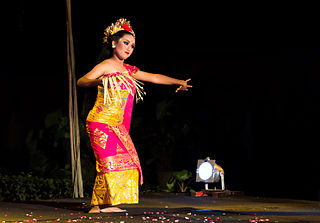
Bali is a province of Indonesia and the westernmost of the Lesser Sunda Islands. Located east of Java and west of Lombok, the province includes the island of Bali and a few smaller neighbouring islands, notably Nusa Penida, Nusa Lembongan, and Nusa Ceningan. The provincial capital, Denpasar, is the most populous city in the Lesser Sunda Islands and the second-largest, after Makassar, in Eastern Indonesia. Bali is the only Hindu-majority province in Indonesia, with 82.5% of the population adhering to Balinese Hinduism.

Kecak, known in Indonesian as tari kecak, is a form of Balinese hindu dance and music drama that was developed in the 1930s in Bali, Indonesia. Since its creation it has been performed primarily by men, with the very first women's kecak group starting in 2006. The dance is based on the story of the Ramayana and is traditionally performed in temples and villages across Bali.

Denpasar is the capital of Bali and the main gateway to the island. The city is also a hub for other cities in the Lesser Sunda Islands.

Pendet is a traditional dance from Bali, Indonesia, in which floral offerings are made to purify the temple or theater as a prelude to ceremonies or other dances. Pendet is typically performed by young girls, carrying bowls of flower petals, handfuls of which are cast into the air at various times in the dance. Pendet can be thought of as a dance of greeting, to welcome the audience and invite spirits to enjoy a performance. It is one of the oldest Balinese dance, although the current form was codified in the 1950s.

Balinese dance is an ancient dance tradition that is part of the religious and artistic expression among the Balinese people of Bali island, Indonesia. Balinese dance is dynamic, angular and intensely expressive. Balinese dancers express the stories of dance-drama through the bodily gestures including gestures of fingers, hands, head and eyes.

Dance in Indonesia reflects the country's diversity of ethnicities and cultures. There are more than 300 ethnic groups in Indonesia: Austronesian roots and Melanesian tribal forms are visible, and influences ranging from neighbouring Asian and even western styles through colonisation. Each ethnic group has its own dances: there are more than 3,000 original dance forms in Indonesia. The old traditions of dance and drama are being preserved in the many dance schools which flourish not only in the courts but also in the modern, government-run or supervised art academies.
I Made Sidia is a Balinese wayang puppeteer. He is one of Bali's most acclaimed shadow artists.

Udayana University is a public university in Denpasar, Bali, Indonesia. It was established on September 29, 1962 and it used to belong to the Airlangga University that mainly located in Surabaya. Its current rector is Prof. Dr. A.A. Raka Sudewi, Sp.S(K). The university's name was derived from the 10th century Balinese King Udayana (Dharmodayana) of the Warmadewa Dynasty.

Indonesian Institute of the Arts Denpasar abbreviated as ISI Denpasar is a college of art organized by the Ministry of National Education which is under and directly responsible to the Minister of National Education. ISI Denpasar functionally supervised by the Director General of Higher Education Department of Education. ISI Denpasar was established in 2003 which is the integration of the Indonesian Arts College (STSI) in Denpasar and Study Program of Art and Design (PSSRD) of Udayana University.
Oka Rusmini is an Indonesian poet and novelist. She is a recipient of the S.E.A. Write Award.

Anggabaya is a small village in Bali, Indonesia.

Condong is a Balinese dance which is often performed as a preface to legong and accompanied by the semar pangulingan style of gamelan. The term also refers to a stock character, a quintessential representation of the maidservant, found in the condong dance, as well as the legong, gambuh, and arja dances.

Panyembrama is a secular Balinese dance form designed by I Wayan Berata and first performed in 1971. It includes movements from several sacral Balinese dances, which it was intended to replace for performance in front of tourists.

Kebyar duduk is a Balinese dance created by I Mario and first performed in 1925. Inspired by the development of the quick-paced gamelan gong kebyar, kebyar duduk is named for the seated and half-seated positions taken by the dancers. It does not convey a story, but is interpretative.

Oleg, often identified as "the dance of the bumblebees", is a form of dance in Bali, Indonesia.

Ayu Bulantrisna Djelantik is a traditional Balinese dance master, an ENT specialist, and a lecturer at the Faculty of Medicine, Padjadjaran University, Indonesia. She is the granddaughter of the last King of Karangasem, Anak Agung Anglurah Ketut Karangasem.

Tan Lioe Ie is an Indonesian poet, the first poet in Indonesia who uses Chinese symbolic images in his poetry. Among friends he is called as Yokie.

Rejang is a sacred Balinese dance, a sacrificial dance in which the girls offer themselves to the gods. It is usually held at the Hindu temple's of Klungkung Regency and Karangasem Regency in Bali, Indonesia. “Rejang” means “offering”, a dance to greet the gods that come down to the Earth. This dance is part of the sacred offering ceremonies, which all happen around about the same time on Bali’s ceremonial calendar.
Ayu Diandra Sari Tjakra is an Indonesian doctor, fashion model and a Beauty pageant titleholder who won the title of Puteri Indonesia Lingkungan 2008. She represented Indonesia at the Miss International 2010 pageant in Chengdu, China, where she won Miss Popularity or People's Choice Award.
Putu Ayu Saraswati is an Indonesian People's Consultative Assembly Ambassador, doctor, fashion model and beauty pageant titleholder who won the title of Puteri Indonesia Lingkungan 2020. She is Known for her work in advocating for elderly care and free healthcare programs. Saraswati is the second delegate from Bali to ever be crowned Puteri Indonesia Lingkungan after Ayu Diandra Sari Tjakra in 2008. She will represent Indonesia at the Miss International 2021 pageant.




















